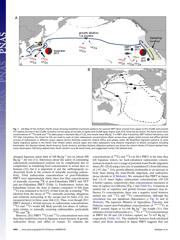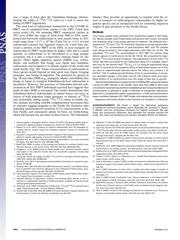Datasheet 搜索 > FPGA芯片 > Altera(阿尔特拉) > EP2C20F484C7N 数据手册 > EP2C20F484C7N 其他数据使用手册 1/4 页

 器件3D模型
器件3D模型¥ 2823.63
EP2C20F484C7N 其他数据使用手册 - Altera(阿尔特拉)
制造商:
Altera(阿尔特拉)
分类:
FPGA芯片
封装:
FBGA-484
Pictures:
3D模型
符号图
焊盘图
引脚图
产品图
EP2C20F484C7N数据手册
Page:
of 4 Go
若手册格式错乱,请下载阅览PDF原文件

Pacific bluefin tuna transport Fukushima-derived
radionuclides from Japan to California
Daniel J. Madigan
a,1
,Zofia Baumann
b
, and Nicholas S. Fisher
b
a
Hopkins Marine Station, Stanford University, Pacific Grove, CA 93950; and
b
School of Marine and Atmospheric Sciences, Stony Brook University, Stony Brook,
NY 11794
Edited by Karl K. Turekian, Yale University, North Haven, CT, and approved April 25, 2012 (received for review March 22, 2012)
The Fukushima Dai-ichi release of radionuclides into ocean waters
caused significant local and global concern regarding the spread of
radioactive material. We report unequivocal evidence that Pacific
bluefintuna,Thunnus orientalis, transported Fukushima-derived
radionuclides across the entire North Pacific Ocean. We measured
γ-emitting radionuclides in California-caught tunas and found
134
Cs
(4.0 ± 1.4 Bq kg
−1
) and elevated
137
Cs (6.3 ± 1.5 Bq kg
−1
)in15Pacific
bluefin tuna sampled in August 2011. We found no
134
Cs and back-
ground concentrations (∼1Bqkg
−1
)of
137
Cs in pre-Fukushima blue-
fin and post-Fukushima yellowfin tunas, ruling out elevated
radiocesium uptake before 2011 or in California waters post-Fukush-
ima. These findings indicate that Pacificbluefin tuna can rapidly
transport radionuclides from a point source in Japan to distant ecor-
egions and demonstrate the importance of migratory animals as
transport vectors of radionuclides. Other large, highly migratory ma-
rine animals make extensive use of waters around Japan, and these
animals may also be transport vectors of Fukushima-derived radio-
nuclides to distant regions of the North and South Pacific Oceans.
These results reveal tools to trace migration origin (using the pres-
ence of
134
Cs) and potentially migration timing (using
134
Cs:
137
Cs
ratios) in highly migratory marine species in the PacificOcean.
pelagic
|
radioactivity
|
bioaccumulation
T
he infrequency of nuclear accidents coupled with potentially
wide-ranging effects on ecosystems and human health make
the dynamics and risks of radionuclide discharge into the envi-
ronment a relatively poorly understood but highly important area
of research (1–4). On March 11, 2011, an earthquake and sub-
sequent tsunami led to flooding of the Fukushima Dai-ichi nu-
clear power plants in Japan. Coolant pumps failed to operate
and the power plant reactors overheated, leading to a release of
radionuclides directly into the ocean exceeding that from any
previous accident (3). The release of radionuclides produced
a1–2 wk pulse that peaked on April 6, 2011 with ocean con-
centrations of 68 MBq m
−3
(3) and an estimated total release of
up to 22 × 10
15
Bq of
137
Cs (4) (1 Bq = 1 disintegration s
−1
). The
dominant long-lived γ-emitting radionuclides
134
Cesium (t
1/2
=
2.1 y) and
137
Cs (t
1/2
= 30 y) were released at a consistent ratio of
about 1 (0.99 ± 0.03) (3), although the ratio of
134
Cs:
137
Cs would
decline slowly over time because of the differential decay rate
constants of the two isotopes (Fig. S1). After considerable di-
lution 2–3 mo after maximum discharge, surface concentrations
still exceeded prior concentrations by up to 10,000-fold in coastal
waters (3) and up to 1,000-fold over a 150,000 km
2
area of the
Pacific up to 600 km east of Japan (4). Before the Fukushima
discharge, low concentrations (1.5 mBq L
−1
) of the long-lived
137
Cs (fallout from weapons testing) were detectable in Japanese
waters (3), whereas the shorter-lived
134
Cs was undetectable in
Pacific surface waters and biota.
The Pacific bluefin tuna (PBFT), Thunnus orientalis, is a highly
migratory fish that inhabits the western and eastern North Pacific
Ocean at various life stages (5) (Fig. 1A). Mature PBFT spawn in
the western Pacific, and some juveniles remain in Japanese waters
while others migrate eastward to the California Current Large
Marine Ecosystem (CCLME) (Fig. 1A), with most migrating late
in their first year or early in their second (5). Thus, all bluefin
between years 1–2 (here, 2-y-old PBFT) caught during summer in
the eastern Pacific must have migrated from the western Pacific
within several months of capture. Waters north of the Kuroshio
Current (Fig. 1A) showed high radionuclide concentrations in
spring 2011 (3), and juveniles make extensive use of this region
before their eastward migration to the CCLME (6).
We tested the possibility that juvenile PBFT served as biological
vectors of radionuclides between two distant ecoregions: the waters
off Japan and the CCLME. We analyzed 2-y-old PBFT caught off
San Diego, CA, in August 2011, known from size to be recent Japan
migrants, for the presence of Fukushima-derived radionuclides.
Because Cs accumulates in the muscle tissue of fish (7), we analyzed
the white muscle tissue of PBFT in 2011 for concentrations of
134
Cs,
137
Cs, and various naturally occurring γ-emitting radionuclides. To
rule out non-Fukushima sources of radiocesium in fish muscle, we
also measured radionuclide concentrations in PBFT collected in
California waters before the Fukushima discharge (2008) and in
yellowfin tuna (YFT), T. albacares (August 2011), in the CCLME
where they are highly residential (8, 9).
Results and Discussion
All 15 PBFT collected in 2011 contained
134
Cs (4.0 ± 1.4 Bq kg
−1
dry wt) and
137
Cs (6.3 ±1.5 Bq kg
−1
) in white muscle tissue (Table
1, Table S1, and Fig. 1A). At the time of capture, total
134+137
Cs
concentrations were about 10 times higher in 2011 PBFT than in
PBFT from previous years (Table 1). In contrast, 2008 PBFT and
2011 YFT had no measurable
134
Cs and consistent, much lower
137
Cs concentrations (consistent with background concentrations
from fallout) than the 2011 PBFT (Table 1, Table S2, and Fig.
1A). This is unequivocal evidence that Fukushima-derived radi-
onuclides were transported to the CCLME by Pacific bluefin tuna,
as no other sources of
134
Cs were present in the North Pacific
preceding the Fukushima disaster (3, 4). Mean concentrations of
the naturally occurring γ-emitting
40
K in the 2011 PBFT were 347
± 49 Bq kg
−1
(Table 1). Other naturally occurring γ-emitting
radionuclides (
7
Be,
211
Bi, and
212
Pb) were detectable at extremely
low concentrations (Table S3), approximately three orders of
magnitude below measured radiocesium concentrations.
Because bluefin tuna are harvested annually in the Eastern
Pacific Ocean (EPO) at 1.7–9.9 × 10
3
metric tonnes (10) (Table
S4) for human consumption (2000 to 2010), the possibility of
radioactive contamination raises public health concerns. Radio-
cesium concentrations of post-Fukushima PBFT reported here
were more than an order of magnitude below the recently
Author contributions: D.J.M. and N.S.F. designed research; D.J.M., Z.B., and N.S.F. per-
formed research; N.S.F. contributed new reagents/analytic tools; D.J.M., Z.B., and N.S.F.
analyzed data; and D.J.M., Z.B., and N.S.F. wrote the paper.
The authors declare no conflict of interest.
This article is a PNAS Direct Submission.
Freely available online through the PNAS open access option.
1
To whom correspondence should be addressed. E-mail: dmadigan@stanford.edu.
This article contains supporting information online at www.pnas.org/lookup/suppl/doi:10.
1073/pnas.1204859109/-/DCSupplemental.
www.pnas.org/cgi/doi/10.1073/pnas.1204859109 PNAS
|
June 12, 2012
|
vol. 109
|
no. 24
|
9483–9486
ENVIRONMENTAL
SCIENCES
器件 Datasheet 文档搜索
AiEMA 数据库涵盖高达 72,405,303 个元件的数据手册,每天更新 5,000 多个 PDF 文件




